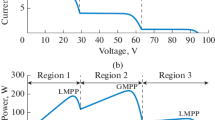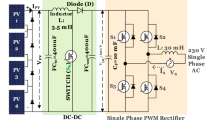Abstract
Photovoltaic (PV) power generation systems know widespread in the power generation world due to their production efficiency of clean energy. This system is exposed to several faults and errors during the production process, which reduces the quality and quantity of the produced energy, among the most common defects is partial shading. This paper proposes a simplified method for fault detection based on the generation of residual signals sensitive to these faults. For this detection, we have developed a model of the healthy photovoltaic system based on an artificial neural network (ANN). The output of this model is compared to the PV generator controlled by maximum power point tracking (MPPT) to form a residue used to feed a mechanism dedicated to fault detection. For the detection mechanism, an ANN was used as a fault classifier. The proposed method makes it possible to determine the percentage of partial shading, even in the presence of climate change. The results have been verified and validated using MATLAB/Simulink.





















Similar content being viewed by others
References
Harrou, F., Saidi, A., Sun, Y., Khadraoui, S.: Monitoring of photovoltaic systems using improved kernel-based learning schemes. IEEE J. Photovolt. 11(3), 806–818 (2021)
Garoudja E, Harrou F, Sun Y, Kara K, Chouder A, Silvestre S: A statistical-based approach for fault detection and diagnosis in a photovoltaic system. 6th International Conference on Systems and Control (ICSC) 75–80 (2017)
Harrou, F., Taghezouit, B., Sun, Y.: Improved k NN-based monitoring schemes for detecting faults in pv systems. IEEE J Photovolt. 9(3), 811–821 (2019)
Ciampi, A., Appice, A., Malerba, D., Muolo, A.: An intelligent system for real time fault detection in PV plants. Sustainability in Energy and Buildings, pp. 235–244. Springer, Berlin (2012)
Li, Q., Zhao, S., Wang, M., Zou, Z., Wang, B., Chen, Q.: An improved perturbation and observation maximum power point tracking algorithm based on a PV module four-parameter model for higher efficiency. Appl. Energy 195, 523–537 (2017)
Obukhov, S., Ibrahim, A., Zaki Diab, A.-A., Al-Sumaiti, A.S., Aboelsaud, R.: Optimal performance of dynamic particle swarm optimization based maximum power trackers for stand-alone pv system under partial shading conditions. IEEE Access 8, 20770–20785 (2020)
Chao, K.-H., Rizal, M.-N.: A hybrid MPPT controller based on the genetic algorithm and ant colony optimization for photovoltaic systems under partially shaded conditions. Energies 14(10), 2902 (2021)
Rajavel, A., Rathina Prabha, N.: Fuzzy logic controller-based boost and buck-boost converter for maximum power point tracking in solar system. Trans Inst Meas Control 43(4), 945–957 (2021)
Khan, U.-H., Khan, Q., Khan, L., Alam, W., Ali, N., Khan, I., Khan, R.-A.: MPPT control paradigms for pmsg-wecs: a synergistic control strategy with gain-scheduled sliding mode observer. IEEE Access 9, 139876–139887 (2021)
Levron, Y., Shmilovitz, D.: Maximum power point tracking employing sliding mode control. IEEE Trans Circuits Syst. Regul. Pap. 60(3), 724–732 (2013)
Miqoi, S., El Ougli, A., Tidhaf, B.: Adaptive fuzzy sliding mode based MPPT controller for a photovoltaic water pumping system. Int. J. Power Electron Drive Syst. 10(1), 414–422 (2019)
Nguyen, X.-H.: Matlab/Simulink based modeling to study effect of partial shadow on solar photovoltaic array. Environ. Syst. Res. 4(1), 1–10 (2015)
Basnet, B., Chun, H., Bang, J.: An intelligent fault detection model for fault detection in photovoltaic systems. J. Sens. 2020, 1–11 (2020)
Alam, M.-K., Khan, F., Johnson, J., Flicker, J.: A comprehensive review of catastrophic faults in PV arrays: types, detection, and mitigation techniques. IEEE J. Photovolt. 5(3), 982–997 (2015)
Alam M-K, Khan F, Johnson J, Flicker J: PV ground-fault detection using spread spectrum time domain reflectometry (SSTDR). IEEE energy conversion congress and exposition 1015–1020 (2013)
Jiang L-L, Maskell D-L: Automatic fault detection and diagnosis for photovoltaic systems using combined artificial neural network and analytical based methods. International Joint Conference on Neural Networks (IJCNN) 1–8 (2015)
Pei, T., Hao, X.: A fault detection method for photovoltaic systems based on voltage and current observation and evaluation. Energies 12(9), 2–16 (2019)
Fadhel, S., Delpha, C., Diallo, D., Bahri, I., Migan, A., Trabelsi, M., Mimounid, M.-F.: PV shading fault detection and classification based on IV curve using principal component analysis: application to isolated PV system. Sol. Energy 179, 1–10 (2019)
Kofinas, P., Dounis, A.-I., Papadakis, G., Assimakopoulos, M.-N.: An Intelligent MPPT controller based on direct neural control for partially shaded PV system. Energy Build 1(90), 51–64 (2015)
Punitha, K., Devaraj, D., Sakthivel, S.: Artificial neural network based modified incremental conductance algorithm for maximum power point tracking in photovoltaic system under partial shading conditions. Energy 1(62), 330–340 (2013)
Alhabib, A., Itako, K., Kudoh, T.: Development of real-time hotspot detection system utilizing artificial intelligence in pv generation system. J. Adv. Sci. 32, 1–7 (2020)
Winston, D.-P., Murugan, M.-S., Elavarasan, R.-M., Pugazhendhi, R., Singh, O.-J., Murugesan, P., Hossain, E.: Solar PV’s micro crack and hotspots detection technique using NN and SVM. IEEE Access 9, 127259–127269 (2021)
Salehi, M., Farhadi, S., Moieni, A., Safaie, N., Hesami, M.: A hybrid model based on general regression neural network and fruit fly optimization algorithm for forecasting and optimizing paclitaxel biosynthesis in corylus avellana cell culture. Plant Methods 17(1), 1–13 (2021)
Talhaoui, H., Ameid, T., Kessal, A.: Energy eigenvalues and neural network analysis for broken bars fault diagnosis in induction machine under variable load: experimental study. J. Ambient Intell Hum. Comput. (2021). https://doi.org/10.1007/s12652-021-03172-2
Pillai, D.-S., Blaabjerg, F., Rajasekar, N.: A comparative evaluation of advanced fault detection approaches for PV systems. IEEE J. Photovolt. 9(2), 513–527 (2019)
Raiker, G.-A., Loganathan, U., Reddy, S.-B.: Current control of boost converter for PV interface with momentum-based perturb and observe MPPT. IEEE Trans. Ind. Appl. 57(4), 4071–4079 (2021)
Khan, S., Zaid, M., Mahmood, A., Nooruddin, A.-S., Ahmad, J., Alghaythi, M.-L., Lin, C.-H.: A New transformerless ultra high gain DC–DC converter for dc microgrid application. IEEE Access 9, 124560–124582 (2021)
Baharudin, N.H., Mansur, M.N.T.T., Hamid, A.F., Ali, R., Misrun, M.I.: Topologies of DC-DC converter in solar PV applications. Indones. J. Electr. Eng. Comput. Sci. 8(2), 368–374 (2017)
Paz, F., Ordonez, M.: Zero oscillation and irradiance slope tracking for photovoltaic MPPT. IEEE Trans. Ind. Electron 61(11), 6138–6147 (2014)
Ali, M.-H., Rabhi, A., El Hajjaji, A., Tina, G.-M.: Real time fault detection in photovoltaic systems. Energy Procedia 111, 914–923 (2017)
Grimaccia, F., Leva, S., Mussetta, M., Ogliari, E.: Analysis and validation of ANN PV power output forecasting at 24 hours ahead. Math. Comput. Simul. 131, 88–100 (2017)
Yuan, Z., Song, N., Pan, X., Song, J., Ma, F.: fault detection, isolation, and reconstruction for satellite attitude sensors using an adaptive hybrid method. IEEE Trans. Instrum. Meas. 70, 1–12 (2021)
Bouchriha I, Ghanem A B, Nouri K: MPPT control of a photovoltaic system based on sliding mode control. International Conference on Advanced Systems and Emergent Technologies (IC_ASET) 12–16 (2019)
Robles Algarín, C., Taborda Giraldo, J., Rodriguez Alvarez, O.: Fuzzy logic based MPPT controller for a PV system. Energies 10(12), 1–18 (2017)
Kinattingal, S., Simon, S.P., Nayak, P.S.R.: MPPT in PV systems using ant colony optimisation with dwindling population. IET Renew Power Gener. 14(7), 1105–1112 (2020)
Merchaoui M, Sakly A, Mimouni M F: Improved fast particle swarm optimization based PV MPPT. 9th international renewable energy congress (IREC) 1–7 (2018)
Nazer, M.N.R., Noorwali, A., Tajuddin, M.F.N., Khan, M.Z., Tazally, M.A.I.A., Ahmed, J., Kumar, N.M.: Scenario-based investigation on the effect of partial shading condition patterns for different static solar photovoltaic array configurations. IEEE Access 9, 116050–116072 (2021)
Vadivel, S., Boopthi, C.-S., Ramasamy, S., Ahsan, M.: Haider J, Rodrigues E-M: performance enhancement of a partially shaded photovoltaic array by optimal reconfiguration and current injection schemes. Energies 14(19), 6332 (2021)
Boggarapu, P.-K., Pillai, D.-S., Rajasekar, N., Manickam, C., Ganesan, S.-I.: Identification and localization of array faults with optimized placement of voltage sensors in a PV system. IEEE Trans. Ind. Electron 68(7), 5921–5931 (2020)
Garcìa, M.-A., Herrmann, W., Böhmer, W., Proisy, B.: Thermal and electrical effects caused by outdoor hot-spot testing in associations of photovoltaic cells. Prog. Photovolt. Res. Appl. 11(5), 293–307 (2003)
García, E., Ponluisa, N., Quiles, E., Zotovic-Stanisic, R., Gutiérrez, S.C.: Solar panels string predictive and parametric fault diagnosis using low-cost sensors. Sensors 22(1), 332 (2022)
Mellit, A., Kalogirou, S.: Assessment of machine learning and ensemble methods for fault diagnosis of photovoltaic systems. Renew Energy 184, 1074–1090 (2022)
Yurtseven, K., Karatepe, E., Deniz, E.: Sensorless fault detection method for photovoltaic systems through mapping the inherent characteristics of PV plant site: simple and practical. Sol. Energy 216, 96–110 (2021)
Colmenares-Quintero, R.F., Rojas-Martinez, E.R., Macho-Hernantes, F., Stansfield, K.E., Colmenares-Quintero, J.C.: Methodology for automatic fault detection in photovoltaic arrays from artificial neural networks. Cogent Eng. 8(1), 1981520 (2021)
Raeisi H A, Sadeghzadeh S M: A novel experimental and approach of diagnosis, partial shading, and fault detection for domestic purposes photovoltaic system using data exchange of adjacent panels. Int J Photoenergy (2021)
Rouani, L., Harkat, M.F., Kouadri, A., Mekhilef, S.: Shading fault detection in a grid-connected PV system using vertices principal component analysis. Renew Energy 164, 1527–1539 (2021)
Rakesh, N., Banerjee, S., Subramaniam, S., Babu, N.: A simplified method for fault detection and identification of mismatch modules and strings in a grid-tied solar photovoltaic system. Int. J. Emerg. Electr. Power Syst. 21(4), 20200001 (2020)
Sathyanarayana, P., Ballal, R., Sagar, L., Kumar, G.: Effect of shading on the performance of solar PV panel. Energy Power 5(1A), 1–4 (2015)
Kaushika, N.-D., Rai, A.-K.: An investigation of mismatch losses in solar photovoltaic cell networks. Energy 32(5), 755–759 (2007)
Author information
Authors and Affiliations
Corresponding author
Ethics declarations
Conflict of interest
On behalf of all authors, the corresponding author states that there is no conflict of interest.
Additional information
Publisher's Note
Springer Nature remains neutral with regard to jurisdictional claims in published maps and institutional affiliations.
Appendices
Appendices
Appendix A: Specifications of PV array
Maximum power (Pmp) | 200.143 (W) |
|---|---|
Maximum voltage (Vmp) | 26.3 (V) |
Maximum current (Imp) | 7.61 (A) |
Open circuit voltage (Voc) | 32.9 (V) |
Short circuit current (Isc) | 8.21 (A) |
Temperature coefficient short circuit (Ki) | 0.00318 (A/°C) |
Temperature coefficient open circuit (Kv) | −0.123 (V/°C) |
Number of cells per module (Ns) | 54 |
Rights and permissions
About this article
Cite this article
Tati, F., Talhaoui, H., Aissa, O. et al. Intelligent shading fault detection in a PV system with MPPT control using neural network technique. Int J Energy Environ Eng 13, 1147–1161 (2022). https://doi.org/10.1007/s40095-022-00486-5
Received:
Accepted:
Published:
Issue Date:
DOI: https://doi.org/10.1007/s40095-022-00486-5




